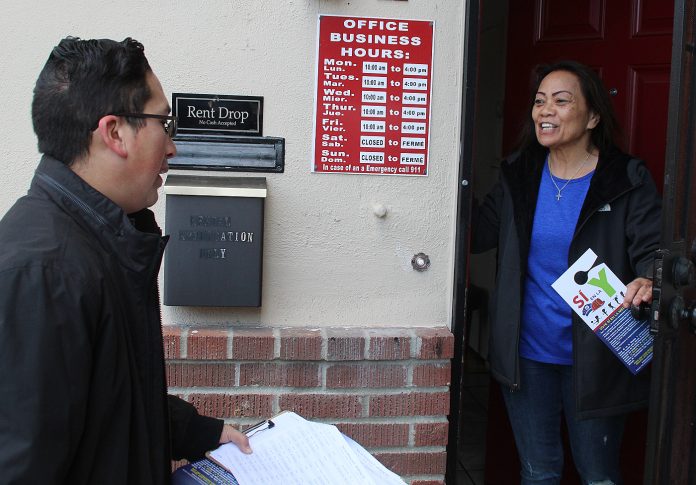
WATSONVILLE—On a typical Saturday morning Watsonville City Councilman Francisco “Paco” Estrada would be sipping coffee, spending time with his family and watching Liverpool F.C. continue its dominance of the English Premier League.
But Jan. 11 was no typical Saturday morning.
Estrada, along with about three dozen other volunteers, laced up his walking shoes, grabbed a clipboard and some pamphlets and put on a smile to start the rapid-fire campaign urging Watsonville voters to extend the half-cent sales tax first passed as Measure G in 2014, and now known as Measure Y.
“I think we all know how important [Measure G] has been for our community,” Estrada said. “Anything I can do to help get the word out, and get people to vote, I’m here for it.”
In the March primary voters will have their say on the measure, which in 2014 made Watsonville the highest-taxed city (then 9 percent, and now 9.25 percent) in the county but promised to bolster its police and fire departments that were struggling to keep up with high demand.
This time around the measure will also support the city’s parks and community services department, as 8 percent of the estimated $4 million raised through the tax will be used to repair and create safe places for young people. Police will receive 54 percent and fire will take in 38 percent.
Another big change: if approved, the tax would stay in place until it is repealed by voters.
Measure G sunsets in 2021.
Measure Y needs two-thirds voter approval.
Estrada was named co-chair of the Measure Y campaign with Santa Cruz County Supervisor Greg Caput. Both were walking door-to-door in District 7—the east side of Watsonville surrounding the East Lake Village shopping center and the homes in the adult villages off Bridge Street—asking voters to renew the tax.
The growing group of advocates on Jan. 11 included local politicians, police officers, firefighters and everyday citizens. None of the police, fire or city employees were getting paid for the time spent campaigning over the weekend, according to Deputy City Manager Tamara Vides.
They plan to hit a new district every weekend leading up to the fast-approaching election. Estrada also plans to stand at the corner of Main Street and Green Valley Road with a giant campaign sign, as he did while he was running for office in 2018.
“I’m going to do what I was doing during my campaign,” said Estrada, who spent his first year in elected office as Mayor. “I’ll be out there every evening, I hope.”
TOGETHER FOREVER
Measure G was first proposed as a stopgap solution to help the city maintain—and possibly improve—its public safety departments during the tail-end of an economic recession. The hope was other funding sources would eventually fill the originally-projected $2.8 million generated by the tax.
Those high hopes have fallen flat. Measure O, which raised the city’s transient occupancy tax to 12 percent, and Measure L, the city’s cannabis businesses tax, have not met the lofty expectations thrust upon them when they were put forth to voters in 2018 and 2016, respectively.
But the city should soon start seeing larger returns on both measures, as the new Hampton Inn & Suites at the corner of Lee Road and West Beach Street is set to open by the start of summer, and changes to the city’s cannabis laws, which include allowing a small number of retail locations, are on the horizon.
Despite that, the city will ask voters to put Measure Y on the books for good instead of giving it an expiration date.
Vides said the removal of the expiration date will allow the city to pursue “long term” plans and goals for all three departments. Those plans will be determined by an independent third-party assessment of community fire and police needs set for June.
That assessment will recur every decade under Measure Y.
“We’ve heard the call for another [fire] station, but building a new fire station is very expensive and we really need to know if we need it,” Vides said. “That’s the good part of Measure Y, it’ll provide us with a data-driven approach to see if it is something we need or if we need help somewhere else.”
Through Measure G funds the fire department has hired eight employees—seven firefighters and an administrative assistant. WPD, meanwhile, has hired 14 people via the measure—seven officers, two police service specialists, a crime analyst, a property and evidence specialist, a youth employment specialist and two Police Activities League employees.
Chief of Police David Honda said having the tax in place in perpetuity would allow the department to continue the progress it has made over the last six years. He pointed to the consistent drop in crime since Measure G was approved in 2014, a year that featured eight murders in city limits. Overall crime dropped nine percent in 2019, and WPD will soon be fully staffed for the first time in decades.
He also highlighted the department’s push to improve its youth prevention programs.
“The impact that we’ve had through the funds of Measure G has been able to transform the community, and I think if we put a timeline on it, it really restricts our ability as a community from continuing to push forward,” Honda said. “If something goes wrong and the community is not happy with us, we can change direction or they can still come back and vote it down.”










